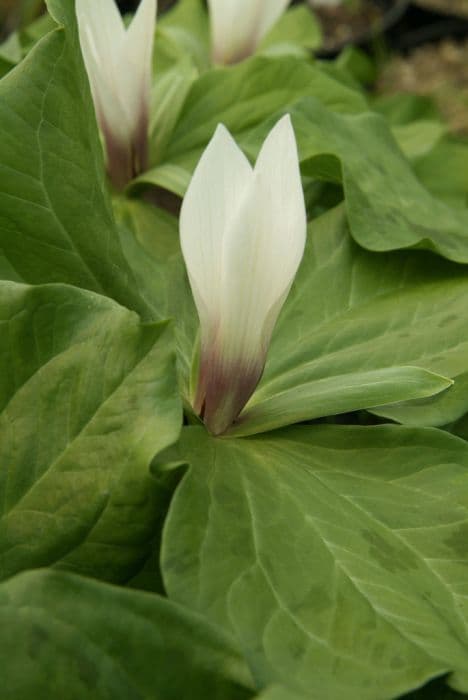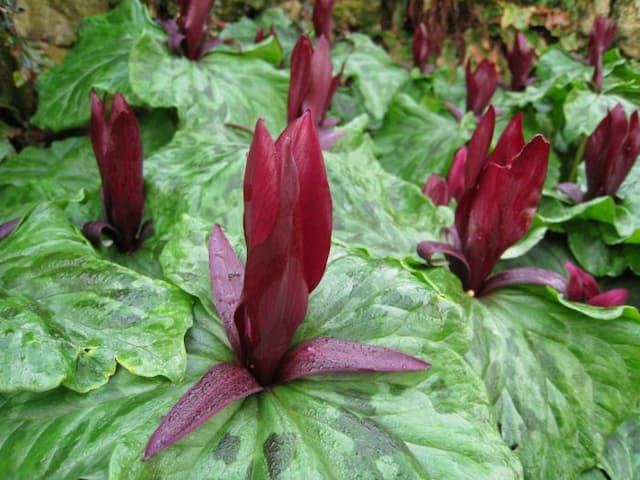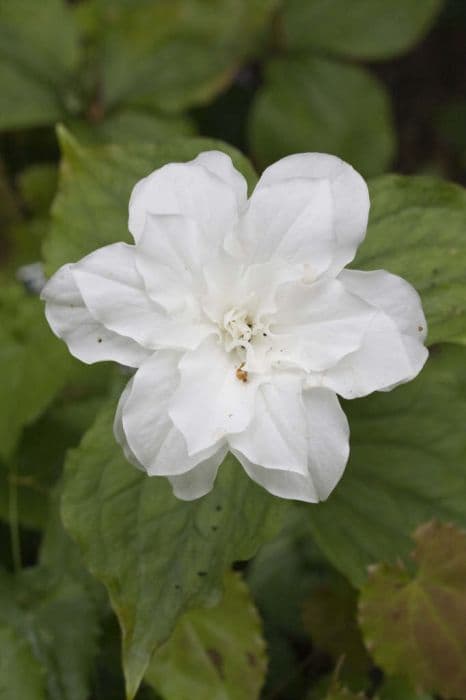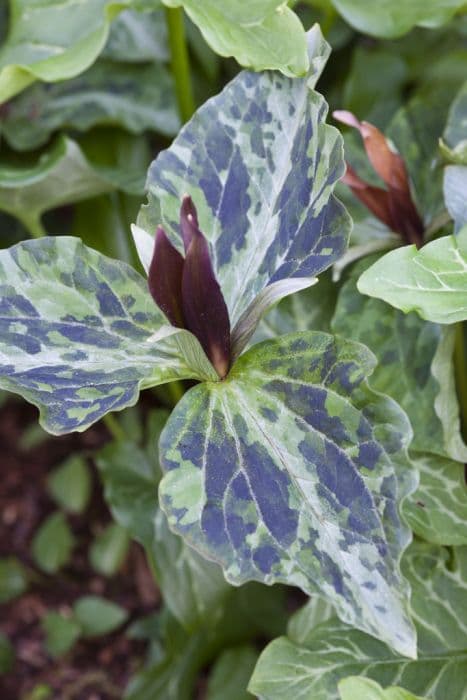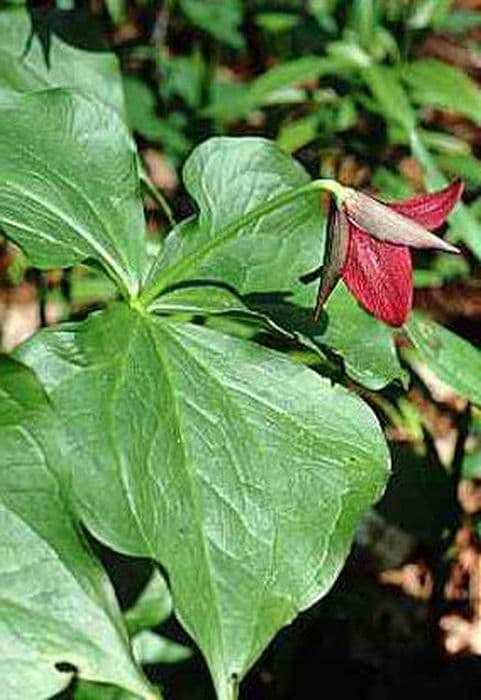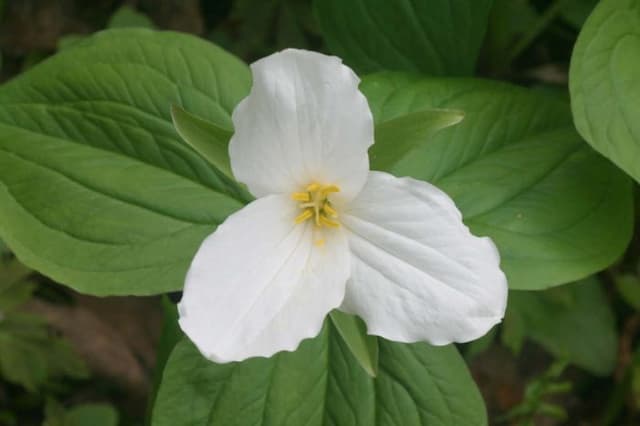Southern Nodding Trillium Trillium rugelii

ABOUT
Trillium rugelii, commonly known as the Southern Nodding Trillium, is a perennial flower that presents a distinctive and elegant appearance. The plant's most noticeable feature is its solitary, showy flower which comprises three large, oval to diamond-shaped petals. These petals are typically white when they first open but may age to a pale pink over time. At the center of the flower, a set of contrasting stamens can be seen which add to the visual appeal of the bloom. Beneath the flower, three broad leaves are arranged symmetrically at the top of the stem in a whorl. These leaves are dark green with a slightly wavy or uneven edge and have a slightly mottled or marbled texture, providing depth and character to the foliage. The flower's position is also a distinguishing characteristic. It rests atop a slender stem and tends to droop or nod downwards, which is why it's described as nodding. This drooping trait gives the plant a graceful and almost shy posture. Finally, the overall arrangement of the Southern Nodding Trillium, with its trio of leaves and a single nodding flower, creates a sense of balance and simplicity that is often appreciated in woodland garden settings or among natural wildflowers where it is native.
About this plant
 Names
NamesSynonyms
Southern Nodding Trillium, Rugel's Trillium.
Common names
Trillium rugelii
 Toxicity
ToxicityTo humans
Trillium rugelii, commonly known as Southern Nodding trillium, is not widely known for its toxicity to humans. There is limited information on the toxicity of this specific species, and it does not typically rank among commonly recognized poisonous plants. However, it is generally recommended not to consume any part of wild plants unless you are certain of their safety, as they may cause adverse reactions such as gastrointestinal discomfort, nausea, or allergic reactions in some individuals.
To pets
Southern Nodding trillium is not typically listed as a toxic plant to pets; however, caution is still advised. As with many wild plants, the lack of specific toxicity information means pet owners should prevent their animals from ingesting parts of the plant. If a pet does consume Southern Nodding trillium and exhibits signs of illness such as vomiting, diarrhea, or drooling, it is important to consult a veterinarian.
 Characteristics
CharacteristicsLife cycle
Perennials
Foliage type
Deciduous
Color of leaves
Green
Flower color
White
Height
1-1.5 feet (30-45 cm)
Spread
1 feet (30 cm)
Plant type
Herb
Hardiness zones
5
Native area
Southeastern United States
Benefits
 General Benefits
General Benefits- Ecosystem Support: Trillium rugelii, commonly known as Southern Nodding Trillium, provides vital nectar for early spring pollinators.
- Biodiversity: It contributes to the botanical diversity of the areas where it grows, which can aid in the stability and resilience of ecosystems.
- Habitat Enhancement: Southern Nodding Trillium can enhance the aesthetic and ecological value of shade gardens and naturalized areas.
- Indicator Species: As a native woodland flower, its presence can indicate a healthy, undisturbed woodland ecosystem.
- Educational Value: It serves as a species of interest for education on native plants, botanical studies, and conservation efforts.
 Medical Properties
Medical PropertiesThis plant is not used for medical purposes.
 Air-purifying Qualities
Air-purifying QualitiesThis plant is not specifically known for air purifying qualities.
 Other Uses
Other Uses- Indicator species: Trillium rugelii, commonly known as the Southern Nodding Trillium, can be an indicator of rich, well-drained forest habitats, which helps ecologists assess the health of an ecosystem.
- Garden aesthetics: Gardeners may use this plant for its distinctive three-petaled flowers and symmetrical leaves to create a visually appealing woodland garden display.
- Natural dye: The Southern Nodding Trillium has been traditionally used to produce green and brown dyes for fabric from its leaves and roots.
- Educational resource: Botany students and educators use Trillium rugelii as a species to study forest ecology and the reproductive strategies of perennial plants.
- Photography subject: Due to its beauty, the plant is often a subject for nature photographers and can be featured in botanical art and educational materials.
- Cultural significance: In some regions, Southern Nodding Trillium is recognized as a cultural symbol of native flora and is planted to celebrate local plant heritage.
- Culinary decoration: While not commonly consumed, its blossoms may occasionally be used as a natural decoration for gourmet dishes in high-end culinary presentations.
- Habitat restoration: Trillium rugelii is planted in native plant restoration projects to help reestablish historical plant communities.
- Seed dispersal study: Scientists may study the plant's seeds, which are spread by ants, to learn about mutualistic relationships between plants and insects.
- Conservation awareness: The species is sometimes used in campaigns to raise awareness about the conservation of native woodland species and their habitats.
Interesting Facts
 Feng Shui
Feng ShuiThe Trillium is not used in Feng Shui practice.
 Zodiac Sign Compitability
Zodiac Sign CompitabilityThe Trillium is not used in astrology practice.
 Plant Symbolism
Plant Symbolism- Elegance: The Trillium rugelii, commonly known as the Southern White Trillium, has a delicate and graceful appearance, which often symbolizes elegance and beauty in the natural world.
- Purity: With its bright white petals, the Southern White Trillium is frequently associated with purity and innocence, as white flowers often are in various cultural traditions.
- Resilience: As a wildflower that blooms in shaded woodland areas, Southern White Trillium represents resilience and the ability to endure challenging conditions while maintaining its poise.
- Recovery: In some regions, seeing the Southern White Trillium return each year after harsh winters or disturbances in its habitat can symbolize recovery, hope, and the renewal of life.
- Trinity: The plant's three-petaled flower can be seen as a representation of concepts that come in threes, such as the Christian Holy Trinity, or other triads like mind, body, and spirit.
 Water
WaterThe Southern Nodding Trillium should be watered deeply once a week during its active growth in spring and early summer, ensuring that the soil is thoroughly moistened but not waterlogged. Regular watering is crucial when the plant is young or newly transplanted to establish a strong root system; one to two gallons per week should suffice, depending on the size of the plant and the weather conditions. Once established, it becomes more drought tolerant and may require less frequent watering. During hot, dry spells, monitor the soil moisture closely and water accordingly to keep the soil consistently moist. Always allow the top inch of soil to dry out slightly before irrigating again to prevent overwatering and root rot.
 Light
LightThe Southern Nodding Trillium thrives in dappled sunlight to partial shade, similar to its native woodland habitat. It's best situated in a spot where it receives filtered light through tree canopies or is shaded from the intense afternoon sun. The ideal lighting condition would mimic the light found on the forest floor, bright enough to provide energy for growth but not so intense as to cause scorching of the delicate leaves.
 Temperature
TemperatureThe Southern Nodding Trillium prefers cooler temperatures and will thrive in a range of 50 to 70 degrees Fahrenheit. It can survive minimum temperatures down to around 40 degrees Fahrenheit, and should not be exposed to temperatures above 80 degrees Fahrenheit for prolonged periods. These cooler temperature ranges often reflect the plant's natural understory habitat where it is insulated by tree canopies.
 Pruning
PruningPruning of the Southern Nodding Trillium is typically not necessary, as it's a self-maintaining plant that dies back naturally in late summer. If you need to remove dead or damaged foliage, it is best to do so after flowering has finished and the leaves have started to yellow. This will ensure that the plant has had enough time to store energy in its rhizomes for the next growing season.
 Cleaning
CleaningAs needed
 Soil
SoilSouthern Nodding Trillium prefers a rich, moist, well-draining soil mix with high organic matter. A blend of equal parts loam, peat moss, and perlite or pine bark would be suitable. The soil pH should be slightly acidic to neutral, in the range of 5.5 to 7.0 for optimal growth.
 Repotting
RepottingSouthern Nodding Trillium does not require frequent repotting and should be repotted only when it outgrows its current container. This might be every 2-3 years. Disturbing the roots too often can harm the plant.
 Humidity & Misting
Humidity & MistingSouthern Nodding Trillium thrives in moderate to high humidity levels, similar to its natural woodland habitat. A range of 60-70% humidity is ideal for this plant.
 Suitable locations
Suitable locationsIndoor
Place in bright, indirect light and maintain high humidity.
Outdoor
Plant in dappled shade, keep soil moist but well-drained.
Hardiness zone
5-9 USDA
 Life cycle
Life cycleTrillium rugelii, commonly known as Southern Nodding Trillium, begins its life cycle as a seed, often dispersed by ants through myrmecochory, which aids in its propagation. Upon germination, which may take several years, a small rhizome develops and initially produces only a single leaf. In its juvenile stage, it continues to grow primarily underground, expanding its rhizome and developing a root system. After a few years, the plant matures and sends up a stem bearing three leaves and a single, nodding flower that blooms in spring, typically white with the potential to turn pink as it ages. Following pollination, often by insects attracted to its scent, the plant produces a berry-like fruit with seeds for dispersal. Southern Nodding Trillium enters dormancy after fruiting, with the above-ground parts dying back, and the cycle repeats with the rhizome surviving underground through winter.
 Propogation
PropogationPropogation time
Spring to early summer
The Southern Nodding Trillium, Trillium rugelii, is most commonly propagated by seed. The most popular method is the collection and sowing of ripe berries which generally occurs in late summer or early fall. Once the berries are collected, they should be cleaned to extract the seeds inside. These seeds have a natural period of dormancy and may take a couple of years to germinate, often requiring a cold stratification process that simulates winter conditions. Cold stratification can be achieved by mixing the seeds with a moist medium like sand or peat moss and refrigerating them at around 35 to 40 degrees Fahrenheit (1.7 to 4.4 degrees Celsius) for at least three months before sowing them in a shaded nursery bed or in pots. The germination rate can be relatively low, and patient caretaking is essential over the several years it takes for the plants to mature and bloom.
